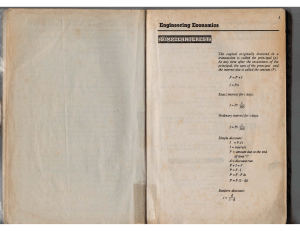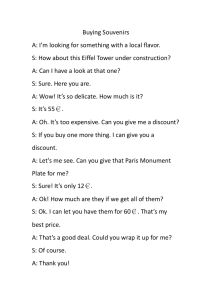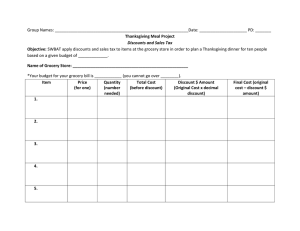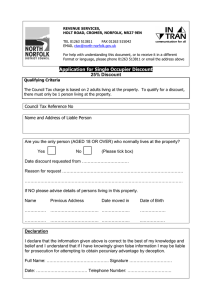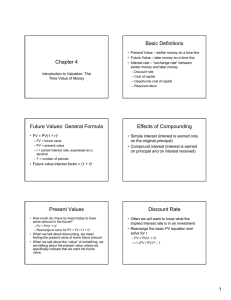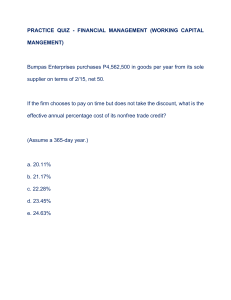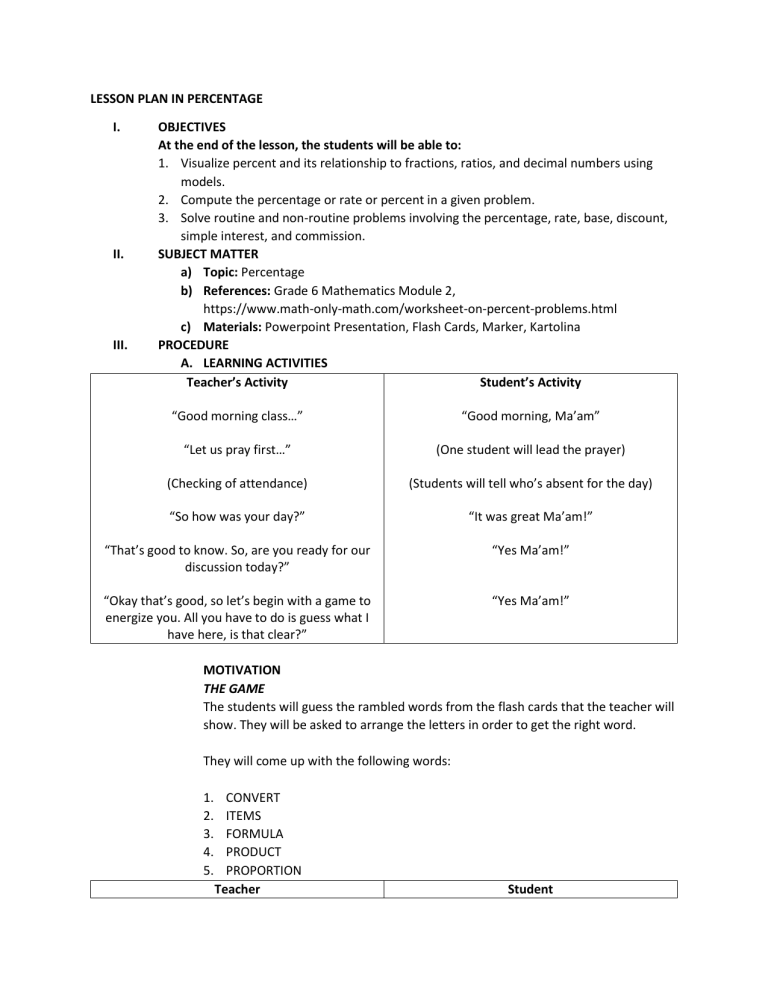
LESSON PLAN IN PERCENTAGE I. II. III. OBJECTIVES At the end of the lesson, the students will be able to: 1. Visualize percent and its relationship to fractions, ratios, and decimal numbers using models. 2. Compute the percentage or rate or percent in a given problem. 3. Solve routine and non-routine problems involving the percentage, rate, base, discount, simple interest, and commission. SUBJECT MATTER a) Topic: Percentage b) References: Grade 6 Mathematics Module 2, https://www.math-only-math.com/worksheet-on-percent-problems.html c) Materials: Powerpoint Presentation, Flash Cards, Marker, Kartolina PROCEDURE A. LEARNING ACTIVITIES Teacher’s Activity Student’s Activity “Good morning class…” “Good morning, Ma’am” “Let us pray first…” (One student will lead the prayer) (Checking of attendance) (Students will tell who’s absent for the day) “So how was your day?” “It was great Ma’am!” “That’s good to know. So, are you ready for our discussion today?” “Yes Ma’am!” “Okay that’s good, so let’s begin with a game to energize you. All you have to do is guess what I have here, is that clear?” “Yes Ma’am!” MOTIVATION THE GAME The students will guess the rambled words from the flash cards that the teacher will show. They will be asked to arrange the letters in order to get the right word. They will come up with the following words: 1. 2. 3. 4. 5. CONVERT ITEMS FORMULA PRODUCT PROPORTION Teacher Student PRESENTATION “Very nice! I am very pleased that you finished the task given to you. Now let’s discuss your answers. Anybody who can tell me what he/she notices with the following words?” DISCUSSION “Very good observation! Now, let me introduce you the Percentage. Would you tell me what is your idea about percentage?” (Student will give their answers) (Student will volunteer to give his/her idea about percentage) “Thank you, are you familiar with percentage?” “Yes Ma’am” “Where do you think we use percentage? Can you give example?” (Student will give some examples.) “Thanks. Now, let’s take a look at the words you guessed a while ago. Could you tell me, what do you think is the relation of these words to our topic today?” “Very good. Well said. Now I will tell you what the percentage mean. So, percentage is the number that represents the part of a whole.” (Student answers: Ma’am, these words will be seen later in the discussion meaning that these words have something to do with the percentage.) “And in finding the percentage, the PBR triangle can help you understand the basic formula. Note that P is on top and B and R are at the bottom. The bar between the top and the bottom means division. The bar between B and R means multiplication. To find P, multiply B and R. Thus, the formula in finding the percentage is P = B × R.” “Again, what is the formula in finding the percentage?” “Very good! Now, I have here an example.” “For example, number 1, what is 56% of 679?” “You can draw a part-whole model to get the answer. If P is the percentage part, then the related proportion is P : 679 = 56 : 100” “Since the product of the means is equal to product of the extremes, then 56 × 679 = 100 × P.” (Student answer: Ma’am, percentage is equal to base multiplied by rate.) “Solving the proportion yields: 38, 024 by 100, and you will get P= 380.24. So, 56% of 679 is 380.24.” “You can simply use the formula. P = 679 × 56%, wherein you need to convert the percent to decimal first. How are going to do that? So, we 56 have 100. Thus, you will have P = 679 × 0.56, which results in 380.24.” “Is it clear?” “Now that you know the PBR triangle, what do you think is the formula in finding the rate?” “Very good! So, I have here an example. There are 45 pupils in Grade 6 Section Newton. Of these, 36 volunteered to join the charitable activity. What percent of them volunteered to join in the activity?” “The percent is what is being asked in the problem. Check the PBR triangle to help you understand the basic formula of finding the rate.” “In the triangle, R is at the bottom and B is under P. It means that R is the quotient of P and B: R = P ÷ B” “It is given in the problem that the total number of pupils is 45. Therefore, the base is 45; the number 36, which is the part of 45, is the percentage; and the rate is the unknown.” “To get the rate of pupils who volunteered to join the charitable activity, divide 36 by 45. Then, change the result into percent.” “Solution: R=P÷B R= 36 ÷ 45 R= 0.8 R=80% Therefore, 80% of the Grade 6 pupils volunteered to join the charitable activity.” “Yes, Ma’am!” (Student answer: Rate is equal to percent divided by base) “Remember that the word percent comes from the Latin per centum. It means "per hundred," or "out of 100." The percent symbol (%) replaces the denominator 100 in a fraction.” “In the given problem, it means that there are 80 shaded squares out of 100 as shown in the given figure. This implies that 80% of the whole is shaded. In decimal form, 80% is equivalent to 0.80 and read as "80 hundredths." To change 0.8 to percent, change the decimal to a decimal fraction. Then, change it to percent: 0.80 -> 80 100 -> 80%” “Now, how about in finding the base? Again, I’ll give you an example.” “Milan is fond of reading fantasy books. She has already read 90 pages of her favorite fantasy book. This is 30% of the total pages of the said book. How many pages does the fantasy book have?” “Since the total number of pages is asked in the problem, you need to find the base. To find the base, divide the percentage by the rate. The PBR triangle will help you understand the formula for finding the base. “ “In the triangle, B is at the bottom with R. P is above the bar. This means that B is the quotient of P and R: B = P ÷ R” “The given in the problem are the percentage and the rate, which are 90 and 30%, respectively. Solution: B= 90 ÷ 30% Substitute the given to the formula. B= 90 ÷ 0.30 Change the percent into decimal. B= 300 Then, divide the percentage by the rate. Answer: The fantasy book that Milan has been reading has 300 pages. Here are more examples on finding the base.” “Now is we have finding discounts; discount is the amount removed or deducted from the original price. To get the sale price of a discounted item, use the formula sale price = original price – (original price × discount rate)” “For example, Judy paid P1,800 for her branded bag at a 10% discount. What was the price before the discount?” “Check what are the given. The price P1,800 is already the amount after the discount has been applied. So, this is already the sale price. In this problem, you are looking for the original price. Remember that Sale Price = Original Price - Amount of Discount” “That means, Sale Price + Amount of Discount = Original Price Sale Price + (Original Price x Discount Rate) = Original Price Sale Price = Original Price - - (Original Price × Discount Rate) Using your knowledge about the distributive property of multiplication, you will have the following: Sale Price = Original Price (1 - Discount Rate) So, to find the original price, you will have the formula: 𝑆𝑎𝑙𝑒 𝑝𝑟𝑖𝑐𝑒 Original Price = (1−𝐷𝑖𝑠𝑐𝑜𝑢𝑛𝑡 𝑅𝑎𝑡𝑒)Applying this to the problem, you will have the following: 𝑃ℎ𝑝1,800 𝑃ℎ𝑝1,800 = (1 − 10%) (1 − 10%) 𝑃ℎ𝑝1,800 = = 𝑃ℎ𝑝2,000 0.9 𝑂𝑟𝑖𝑔𝑖𝑛𝑎𝑙 𝑃𝑟𝑖𝑐𝑒 = To check, apply the formula for the sale price. Sale Price = Original Price - (Original Price × Discount Rate) = P2,000 - (P2,000 × 10%) = P2,000 - (P2,000 × 0.1) = P2,000 - P200 = P1,800” “Next is commission, what is commission?” “That’s right and to get the commission, we can use the formula Commission = Original Price × Rate of Commission” “For example, Mr. Bautista is a hard-working person. He earns by selling appliances. Apart from his monthly salary, the company gives him 15% commission for all his sales. If his total sales is P25,000, how much is his commission? Applying the formula, you will have the following: Commission = 15% × P25,000 = 0.15 x P25,000 = P3,750 Mr. Bautista's commission from selling appliances is P3,750.” “Another example, Michelle sold a van for P1,700,000 and earned P255,000 as commission. (Student Answer: Commission is a percent of the selling price,) What is the rate of commission given to her? Applying the formula, you will have the following: P255,000 = P1,700,000 × Rate of Commission 𝑃ℎ𝑝255,000 𝑃ℎ𝑝1,700,000 = Rate of Commission 0.15 = Rate of Commission Since rates are expressed as percent, you need to multiply it by 100%. Rate of Commission = 0.15 x 100% = 15%” “Last is the simple interest. Interest is the amount of money owed for the use of money lent over a period. Other terms that are used in solving simple interest problems are the following: “ “Principal (P) refers to the amount of money borrowed, invested, or deposited Rate of Interest (R) refers to the percent added to the principal amount. Time (T) refers to the length of time the money has been deposited, invested, or borrowed. The following formula is used in solving simple interest, where interest is represented by I, principal by P, rate of interest by R, and time by T: I = P x R x T” “Example, Ariel invested P500,000 in a lending house, which gives an annual rate of interest of 5.5%. How much interest will Ariel receive after 2 years?” “First, understand the problem. The given are the following: P= Php500,000 R= 5.5% T= 2 years You need to find the amount of interest Ariel will receive after 2 years. Then, plan. To get the interest, multiply the principal by the rate and time. Use this formula I = P×R×T Third, solve and substitute the given for the formula. I = P500,000 multiplied by 5.5% 2 I=P500,000 × 0.055% × 2 I = 55,000 pesos Ariel will receive an interest of Php55,000.” “Is everything clear with you students?” ANALYSIS “Yes Ma’am!” ” Since it’s already clear, I will give you a short activity.” “I want you to answer the following:” 1. What is 12% of 150? 2. What percent of 350 is 50? 3. What percent of 800 is 200? GENERALIZATION “Now, class, let’s remember that if the percentage is P, the base is B, and the rate is R, then: P = B × R, B = P ÷ R, R = P ÷ B.” “And let us also remember to get the sale price of a discounted item, use the formula Sale Price = Original Price – (Original Price × Discount Price). For commission we have, Commission = Original Price× Rate of Commission And for interest is I = P× R × T (Student answers: P=18, B=150, R=12% P=50, B=350, R=14% P=200, B=800, R=25%) APPLICATION Independent Activity: Read and understand each word problem. Write your solution in the space provided. 1. There were 300 participants who attended a seminar. Of these, 200 were males. What percent were males? 2. Mr. Dela Cruz gave his son, Ron, a box of rubber bands. In the box, there are 100 rubber bands, of which 25 are blue. What percent of the rubber bands are blue? 3. Wilfred sold 40 sacks of rice from his harvest. This number was 70% of his harvest. How many sacks of rice were his harvest? EVALUATION Directions: Express each of the following percent (%): 1. 3/5 2. 1 ½ 3. 3/10 4. 13/20 5. 0.86 6. 0.73 7. 3.28 8. 1.073 ASSIGNMENT Direction: Answer the following questions to summarize what you have learned from the discussion. Write your answer in the blanks provided. 1. How do you solve for percentage given the base and the rate? ______________________________________________________________________________ ______________________________________________________________________________ 2. What is the difference between discount, commission and interest? ______________________________________________________________________________ ______________________________________________________________________________
